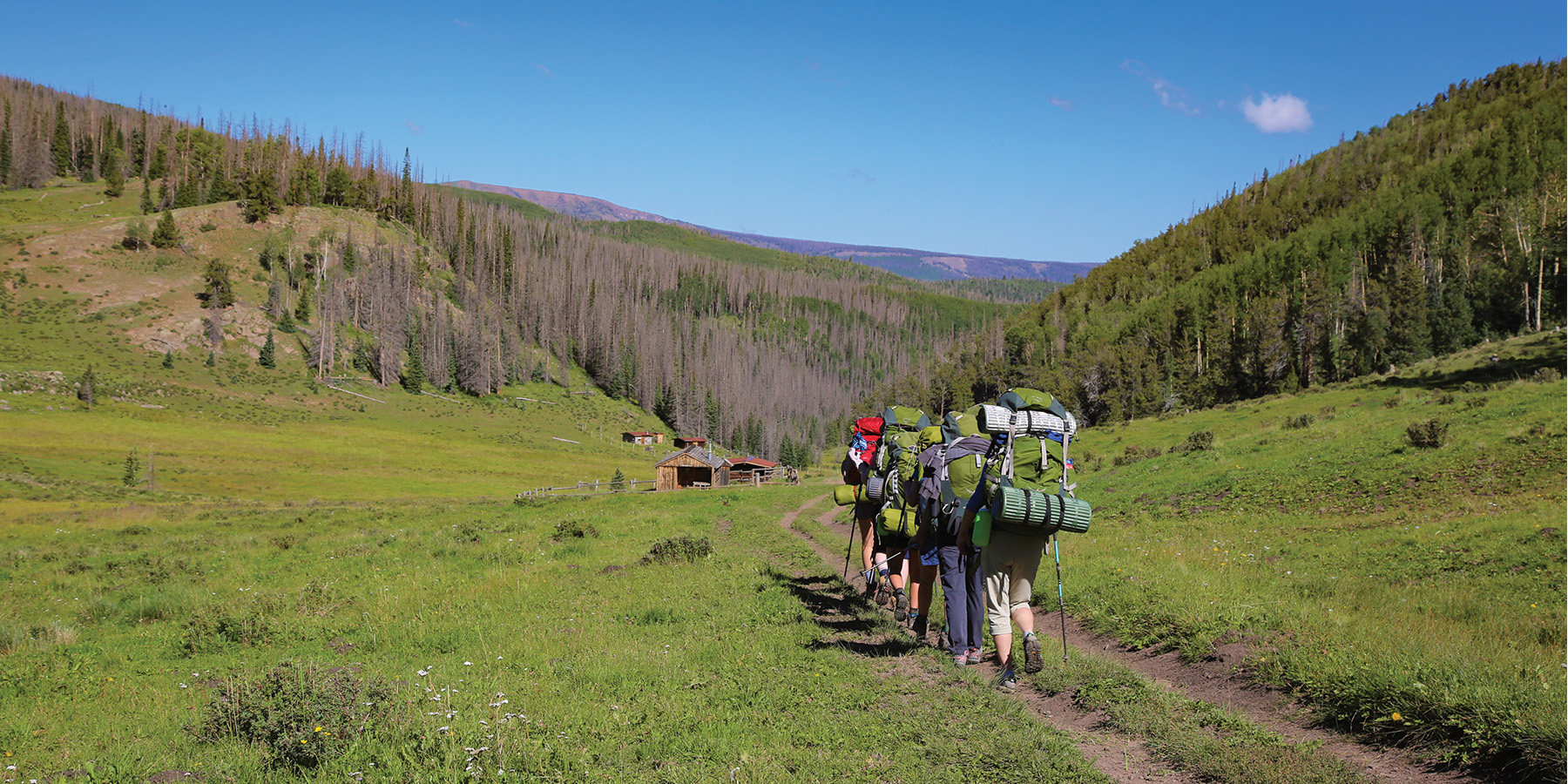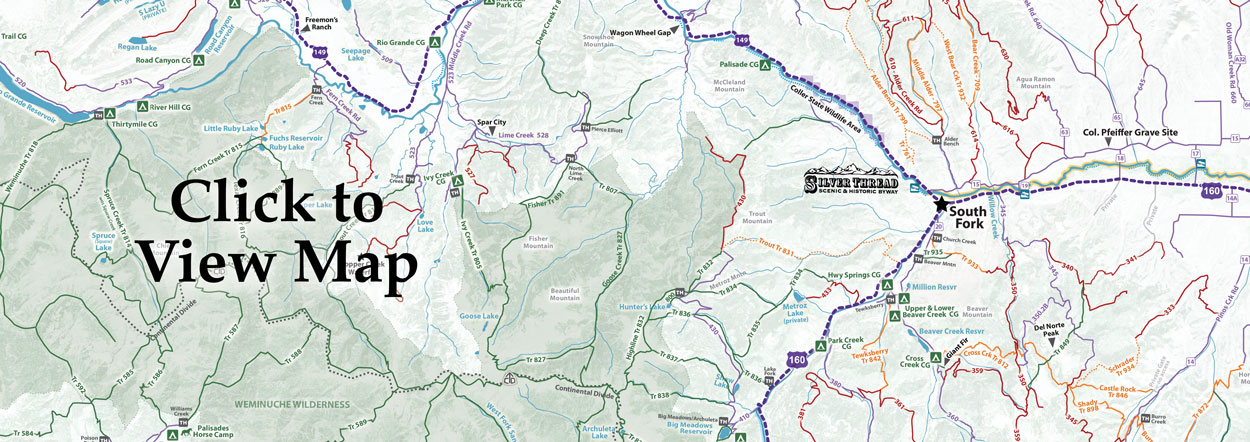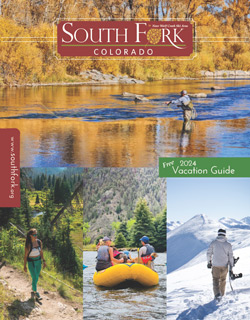Almost 2 million acres of the Rio Grande National Forest surrounds the South Fork area, providing a mulitude of backpacking opportunities, including the Continental Divide Trail.
CDT Gateway Community Check Fire Bans
Know Before You Go
- Tell Someone: Where you’re going When you’ll be back
- Maps - don’t rely on cell service. Either have them printed or downloaded.
- Stick to the trails; Leave any gates the way you find them!
- Buy a Search & Rescue Card ($3 online). The card helps reimburse local SAR team’s expenses for search and rescue missions
- Check local fire conditions. After the forest fire in 2013 that ravaged our economy and our national forest, we take fire bans SERIOUSLY. If you do have a campfire, extinguish it fully!!!
- Plan for cold nights, even in July! At high elevations, temperatures drop significantly once the sun goes down
Intro to Backpacking the Weminuche Wilderness
By Sharleen Lucas, RN, WEMT
South Fork is a well-known gateway to the beautiful Weminuche Wilderness, Colorado’s largest Wilderness area spanning the Continental Divide from Wolf Creek Pass almost to Silverton. If you’re new to backpacking and need a few Weminuche Wilderness tips, you’re at the right place. With its average elevation of 10,000 feet, the Weminuche’s rugged and wild terrain requires careful planning. Knowing what to bring and how to pack is the first step to a safe and unforgettable trip.
The Backpacking ABCs
Let’s start with the “ABCs” of backpacking from NOLS, a well-respected wilderness school.
Accessible: Digging into the bottom of your pack midway to your next campsite is a dreaded task. Experienced backpackers pack items according to how often they use them throughout the day. You certainly don’t need your sleeping bag near the top of your pack, but having your water purifier, navigation tools, and rain gear within reach is essential.
Balanced: A balanced pack isn’t just for comfort. It keeps you steady on the trail, making you less likely to fall and injure yourself or stumble into a cold, rocky stream. It also distributes the weight in a way that makes the pack feel lighter with less strain, minimizing sore muscles later. We discuss this principle in depth below.
Compressed: Good compression throughout the pack allows everything to fit and helps with weight distribution. If your sleeping bag is bulky, stuffing it into a compression bag saves a lot of space. Carrying down (or synthetic down) clothing rather than fleece is beneficial because it compresses into small bundles to tuck into pockets of space. You can fill items you can’t compress, like a cooking pot, with small items before placing them into the pack.
Dry: Summertime is the wettest time of the year in the Weminuche, a surprising fact. Monsoonal rains and afternoon thunderstorms loom about 20% of the time between July 9 and October 4. Keeping your pack dry keeps your extra clothes dry, preventing hypothermia and general backpacking blues. You can line your pack with a large garbage bag or fit a rain fly around the pack’s exterior.
Everything inside: Packing most gear inside your pack is another way to keep items clean and dry, create a balanced pack, and reduce your chances of losing gear to the trail’s lost and found pile or snagging it on trees and rocks.
How to Pack a Balanced Backpack
- Bottom
- Sleeping bag: Most backpackers first place this at the bottom of their pack.
- Sleeping pad: Some pads are too large to stuff into the bottom. You can stand them vertically inside the pack or strap them to the exterior.
- Camp clothes: You can stuff clothes needed at camp but not during the hike into the bottom or middle back
- Middle back
- Meals packed into a bear canister or bag (don’t forget hanging cord for bags)
- Cooking kit & utensils
- Stove & fuel
- Water reservoir (unless you carry water bottles instead)
- Tent and tent accessories
- Tip: The Weminuche Wilderness does not require bear cans, but the forest service recommends them for protection from black bears and other animals.
- Middle front
- Camp towel
- Toiletries
- Light-weight clothing
- Tip: Where to put electronic devices (chargers, GPS devices, cell phones, extra batteries, etc.) depends on their weight, size, and frequency of use. Following these packing principles, place them where it works best for your situation.
- Top
- Raincoat
- Insulated jacket
- Hat & gloves
- First aid*
- Survival kit*
- Repair kit*
- Knife or multi-tool
- Water purifying system
- Navigation tools
- Sunscreen
- Toilet paper & trowel
- Biodegradable soap
- Snacks
- Tip: Water is abundant in the Weminuche, which boasts headwaters flowing to the Atlantic and the Pacific. Be sure you have a trustworthy water purifying or filtration device to clean any water before drinking. Always inspect and test that device before departure and know where to get water along your hiking route. *See below for more information
- Exterior Pockets
- Most packs allow exterior pockets for things you need to access throughout the day, like maps, cell phones, lip balm, sunglasses, sunscreen, bug spray, snacks, Wilderness permits, emergency contact information, etc. Water bottles, water/camp shoes, and bear spray often fit into exterior mesh pockets. You can hook car keys to a clasp inside a pocket which most newer packs offer.
- Loops & lash points on the pack’s exterior
- Attaching items to loops or fasteners on the exterior is typically based on personal preference (like sanitation trowel, camp chair, trekking poles, and water shoes) and gear size (like a large sleeping pad). Overall, be sure to place as much as possible inside your pack.
- Tip: Hang a damp camp towel or tent from the pack’s exterior to allow them to dry as you hike but be sure not to snag the tent!
How to hoist your pack to protect gear and body
- Loosen straps that will secure the pack to your body.
- Using the haul loop located outside and on the top of the pack, lift the pack onto your thigh and then slip one arm into the arm strap while still holding on to the haul loop.
- Sling the pack onto your back and slip your other arm through the second arm strap.
- Finish by securing the pack to your body.
Tip: Practice carrying the pack before you leave. The bulk of the weight should rest on the top of your hip bones (iliac crest). The pack is likely the wrong size for you if it doesn’t. With the pack securely on your hips, you can adjust shoulder, sternum, and load lifter straps. Adjusting is a dynamic process throughout a hike, so feel free to adjust straps as you hike to find what works best for your body or to relieve pressure points.
Weminuche Wilderness Tips
- South Fork Visitor Center: stop by for great maps and advice
- Know Before You Go
- Fire: We each are responsible to local communities and environments to “know before you go.” You must research the local area’s fire rules. Remember, you are a guest wherever you vacation. Please do what’s right to help keep the local area safe and thriving.
- Leave No Trace: Check out these seven essential principles.
- Elevation safety: In the Wemuniche Wilderness, you are at risk of altitude sickness, which ruins your adventure and is dangerous when left unaddressed. You should know how to prevent altitude sickness before starting your hike.
- Gear: Check out nearby outdoor recreation stores for gear & resources on South Fork’s website.
- Bears: Bear encounters are rare, but it’s wise to bring bear spray and bear cans to protect yourself from aggressive animals.
Weminuche Trail Recommendation
Try this 24-mile loop for a memorable two-four day hike, depending on how many miles you’d like to hike each day. Park at Thirty Mile Campground and head out on Grizzly Creek Trail-814. Hike towards Grizzly Lake. Continue to Weminuche Trail 818, which takes you back to Thirty Mile Campground. Feel welcome to stop by the South Fork Visitor Center for more information and a map.
Essential Wilderness resources:
- Link to Weminuche Wilderness on Forest Service site
- Weminuche trip planning pamphlet link
- Wilderness Restrictions
Essential First Aid What and how much to pack in a first aid kit depends on the length of your trip, local area challenges, number of hikers, and personal medical needs.
- Here are ten essentials:
- Antiseptic wipes
- Assorted bandages
- Gauze & nonstick sterile pads
- Pain, inflammation, and fever relief: ibuprofen and Tylenol
- Benedryl: for allergic reactions
- Aspirin for hikers with cardiac conditions
- Electrolyte replacement packets like Emergen-C
- Small patches of moleskin for blister treatment
- Sling & swath (or ability to improvise with clothing)
- SAM splint (or ability to improvise a splint)
- Essential Survival Kit
- Firestarter items
- Backup water purifying tablets
- Reflective blanket
- Extra batteries
- Extra meal
- Signaling mirror
- Whistle
- Navigation tools
- Essential Repair Kit
- Strips of duct tape in small rolls or commercial gear adhesive patches
- Thread (or tooth floss for its strength) and needle
- Zip ties
- Stove repair items
- Paracord: very strong, damage-resistant, and versatile
- Tent pole sleeves for pole repair
Sharleen Lucas is a registered nurse and freelance health writer. After serving at the hospital bedside for many years, she now enjoys combating her addiction to health research and outdoor expertise by passing them on as the RNextdoor. When she’s not overthinking her writing, she plays in the mountains or volunteers at the South Fork Fire Station and Rio Grande County Search and Rescue as an EMT. You can read more of her work at https://www.rnextdoor.com.














